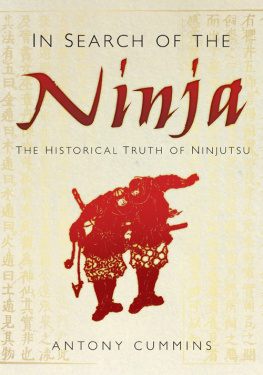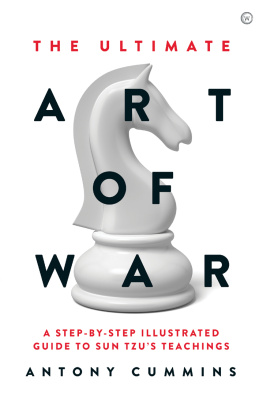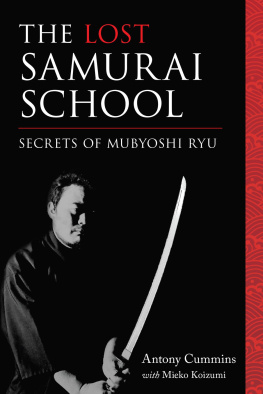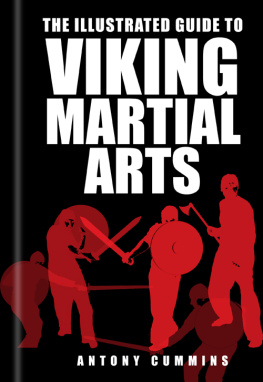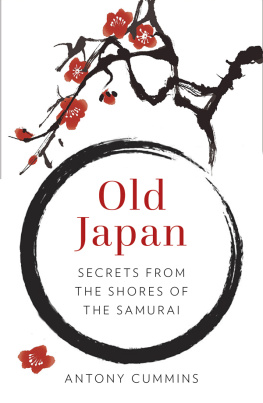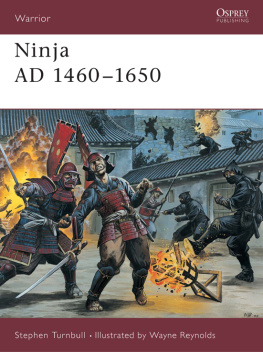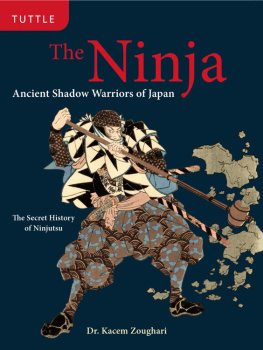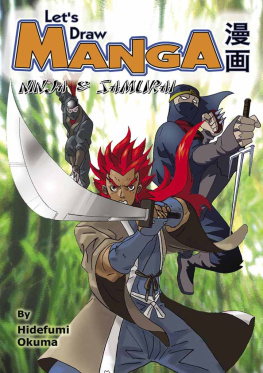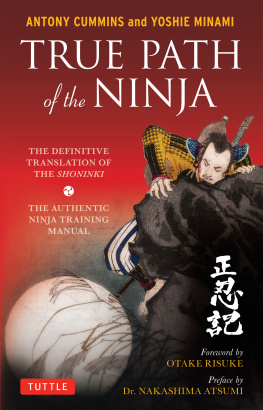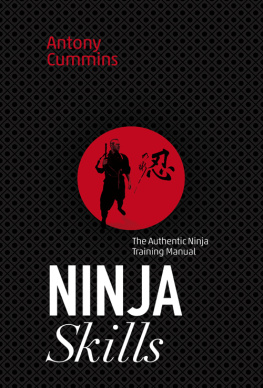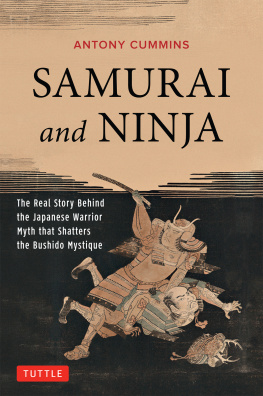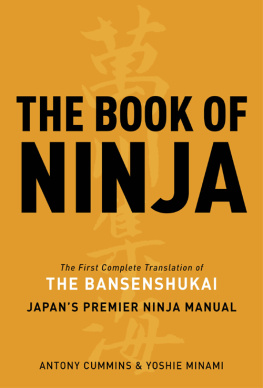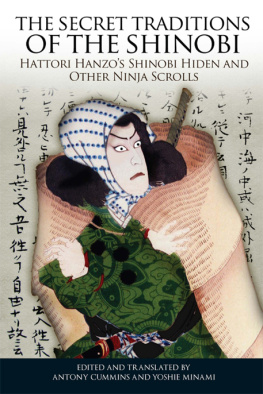
This book is dedicated to my Mother
Judith Wilkinson.
T he following people have given their time and help and I would like to thank them all for their hard work.
All Japanese translation by Yoshie Minami and the Historical Ninjutsu Research Team. Her translations of ninjutsu documents provide the backbone to this work and the entire foundation of my research is based on her kindness. Research into ninjutsus connection to Kusunoki Masashige was aided by Steven Nojiri, who was a huge help in all aspects of Japanese history and Buddhism. I thank Jayson Kane for his wizardry in the area of graphic design and endless help with covers and jacket designs. All chemical analysis was undertaken by Alex Allera of the Chemistry Department of Turin University, whose help has brought clarification to the provenance of some of the art. Also, a thank you to Christa Jacobson, for her help in relation to the Koka Shinobi no Den Miraikai and the Koka Ryu Ninjutsu Densho scrolls. Thanks to Peter Brown of Brighton, England, for allowing the use of his copies of the Rodanshu transcription.
Thank you to Mieko Koizumi for her hard work transcribing documents from very difficult Grass-style into something readable. Also, to Masako (Natori) Asakawa and Yasuko (Natori) Hine, who are the last of the Natori line and to monk Juho Yamamoto for his continuing care of the Natori clan graves. I am grateful to Mr Yoshida Shigeo for his help in authenticating scrolls.
All Chinese translations are quoted from the work of Ralph D. Sawyer unless otherwise stated. His work has been chosen for its academic excellence and to give a uniform translation of the Chinese Classics.
Contents
This scroll should be passed down to one person. That person should train as a Musha-warrior and be familiar with the mountains and fields, the forests and the oceans and he should understand the tactics of war, how to form military camps, understand castle planning, topography and travel around the provinces. Master Matsumoto [Jirozaemon] did this for a long time without stopping and he trained for years on end. These are the secrets of Koka.
Iga-ryu Koka-ryu Shinobi Hiden
You should build watch fires in front of your position, close all the gates and allow no one to come or go without questioning, this is done to block the enemys shinobi.
Heiho Nukigaki Hippu No Sho Gunshi No Maki , 1689
F inding the Ninja is a task that is harder today than it ever has been in history. Whilst the contemporaries of the ninja had to search moonlit thickets and windy bamboo forests with only the shadows of the night to contend with, a modern searcher for the illusive shinobi has to hunt through dusty libraries and negotiate with collectors who guard their treasures with ferocity.
The first step in this quest is to emphasise that there has never been any authoritative form of academic research conducted into these Japanese figures, even though they are one of the most popular Japanese exports; no one has ever really explored the question, who are the ninja? Many think that they know the answer and that the ninja figure is well defined, however, most of their information comes from films, comics, hearsay and a splash of fantasy, mixed with a little faith. In truth, the medieval documents that describe the actions of the ninja sometimes written by the actual agents themselves or by those around them, or by those defending against them have never actually been seen in full in the west and are rarely seen outside of certain circles in Japan.
You are about to venture deep into the history of the ninja, hopefully your preconceptions will be torn away as we unmask the shinobi and break him down into his component parts, stripping away the fantasy and arriving at the truth.
To begin with, this will be done by exposing what is believed to be the origin of the ninja and then replacing it with the facts. Like Hansel and Gretel we will then trace the breadcrumbs into the darkness, through the grammatical gore and the slippery surface of syntax. We will fully investigate the issues, trying to identify if an ideogram in the historical record means ninja or in secret or even to persevere, as a slight change in grammatical form can radically alter a documents meaning.
We shall cut through the ninja versus samurai mythology and find the stark reality that there never was a struggle between the samurai and the shinobi. The myth of the ninja underdog fades to reveal the reality of the highly trained samurai-spy, who is well known and utilised by the Japanese generals of old. From this point, we will survey the evolution of the Japanese scout and his deep connection with the ninja and the subtle differences between the two.
Having found who the ninja are, the quest will turn to where they came from, a query that ends in the Japanese Dark Ages, where literature for the ninja is non-existent and all trails fade away. But the shape of the ninja footprint can be discerned hundreds of years earlier in China, where we find a series of highly interesting connections to the shinobi and a collection of undeniable ninja skills being used on mainland Asia, centuries before the ninja.
These Chinese elements of ninjutsu are rarely touched upon, but all are fascinating and all are screened here by academic investigation and even chemical analysis. These skills are then cross-referenced to many original Japanese manuals to find that the ninja did have common themes and skills, similar enough to show a central curriculum shared by all the old ninja of Japan, but different enough to show that evolution had occurred within the clans. The text will then analyse the secret oral traditions and concentrate on two of the most famous ninja families, the Hattori and the Natori clans, who have left us documents to follow. This will explain why the people from the provinces of Iga and Koka became legendary in their own time, being hired out and recognised as the premier ninja of the day and retaining that pre-eminence for generation after generation. The myth of the female ninja is then explored.
At this point, we consider 1603 as the date of the sowing of the seed of destruction for the ninja and one which means over 200 years of decay; gradually the core of the ninja arts weakens and eventually dies the headstone reads Killed by the abolition of the samurai class and the Meiji Restoration in 1868. In this ninja graveyard we can view the ghost of ninjutsu as it briefly reappears in the Second World War. The investigation will touch upon what is best described as ninja tomb robbery, as pretenders and frauds feed off the modern ninja boom and change the once devastatingly effective, practical arts of the ninja into a global brand, manipulating the ninja into a dark hero figure for profit.
With the revelation that the ninja have long been dead and their arts only to be found on library shelves, the manuals and documents pertaining to the ninja as translated by the Historical Ninjutsu Research Team finally give an all-round understanding of the path of the ninja. The evidence of the true skills and the manuals that record the decline of the ninja during a shift towards the mythical are examined for the first time in the English language.
For some this book will shake their long-held beliefs about ninjutsu, for those who are new to the ninja, it will be as a scribe inking on fresh paper. It may even offend some. For all, it should lay the foundation for future ninja research, destroying the false and promoting the real.
A ny ideas or statements that do not appear in the original text but are assumed from the context are in square brackets. All measurements are given in their Japanese form, such as Bu , Momme , Sun, etc and their equivalent can easily be obtained from various sources; however, a select table of measurements is supplied .
Next page
